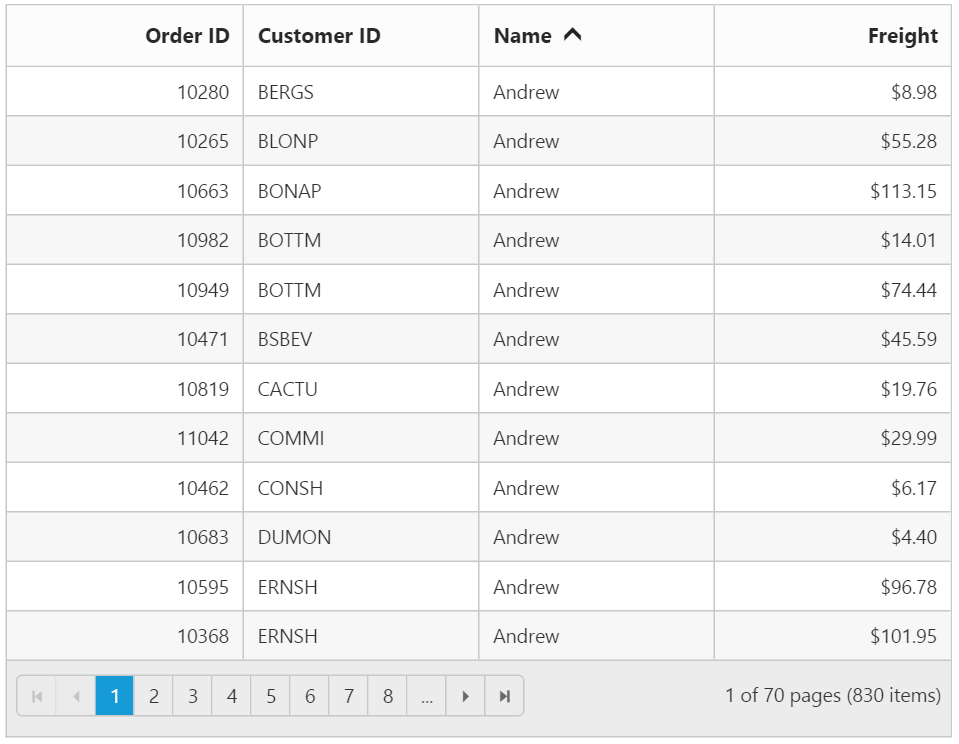Data Adaptors
12 Sep 202324 minutes to read
The Data adaptor is a mechanism through which the DataManager interact with the remote service or local dataSource. The DataManager has several preconfigured Data Adaptors, refer to the link.
In Grid, the adaptor can be specified using the Adaptor property of the DataManager.
JSON Adaptor
The JSON Adaptor is used when the grid is bound with local datasource. It can be enabled in Grid using Adaptor property as ` JsonAdaptor. The JsonAdaptor is the default adaptor used by DataManager` when bind with datasource controls such as SqlDataSource, ObjectDataSource and also while using datasource such as IEnumerable, DataTable etc.
The following code example describes the above behavior.
<ej:Grid runat="server" ID="Grid">
<Columns>
<ej:Column Field="FirstName" HeaderText="First Name"></ej:Column>
<ej:Column Field="LastName" HeaderText="Last Name"></ej:Column>
<ej:Column Field="Email" HeaderText="Email"></ej:Column>
</Columns>
</ej:Grid>namespace Grid
{
public partial class _Default : Page
{
protected void Page_Load(object sender, EventArgs e)
{
List<Person> Persons = new List<Person>();
Persons.Add(new Person() { FirstName = "John", LastName = "Beckett", Email = "[email protected]" });
Persons.Add(new Person() { FirstName = "Ben", LastName = "Beckett", Email = "[email protected]" });
Persons.Add(new Person() { FirstName = "Andrew", LastName = "Beckett", Email = "[email protected]" });
this.Grid.DataSource = Persons;
}
}
}The following output is displayed as a result of the above code example.

WebMethod Adaptor
The WebMethod Adaptor is used to bind data source from remote services and code behind methods. It can be enabled in Grid using Adaptor property of DataManager as WebMethodAdaptor.
For every operations, an AJAX post will be send to the specified data service.
When using WebMethodAdaptor, grid actions such as Paging, Filtering and Sorting should be handled at the server side itself. We have DataOperation class to handle the server side operations. Refer to the kb link. These operations can also be done using the QueryableDataOperations class which accepts the IQueryable Data. Please refer the Kb link.
WebMethod Adaptor supports Model Binding, using DataManager class, for the Grid queries, such as sort, paging queries, etc.,
NOTE
• The response from server should be wrapped in object with properties named
resultto hold the data andcountto hold the total records count.
NOTE
• The
countmust be returned along with response when paging is enabled in Grid.
NOTE
• The data parameter name must be “value”
You can use the following code example to use WebMethod adaptor.
<ej:Grid ID="EmployeesGrid2" runat="server" AllowPaging="true">
<DataManager URL="Default.aspx/DataSource" Adaptor="WebMethodAdaptor" />
<Columns>
<ej:Column Field="OrderID" />
<ej:Column Field="EmployeeID" />
<ej:Column Field="CustomerID" />
<ej:Column Field="OrderDate" />
<ej:Column Field="Freight" />
</Columns>
</ej:Grid>namespace EJGrid
{
public partial class _Default : Page
{
[WebMethod]
[ScriptMethod(ResponseFormat = ResponseFormat.Json)]
public static object DataSource(DataManager value)
{
IEnumerable data = OrderRepository.GetAllRecords();
var count = data.AsQueryable().Count();
DataOperations ds = new DataOperations();
data = ds.Execute(data, value);
return new { result = data, count = count };
}
}
}The following output is displayed as a result of the above code example.
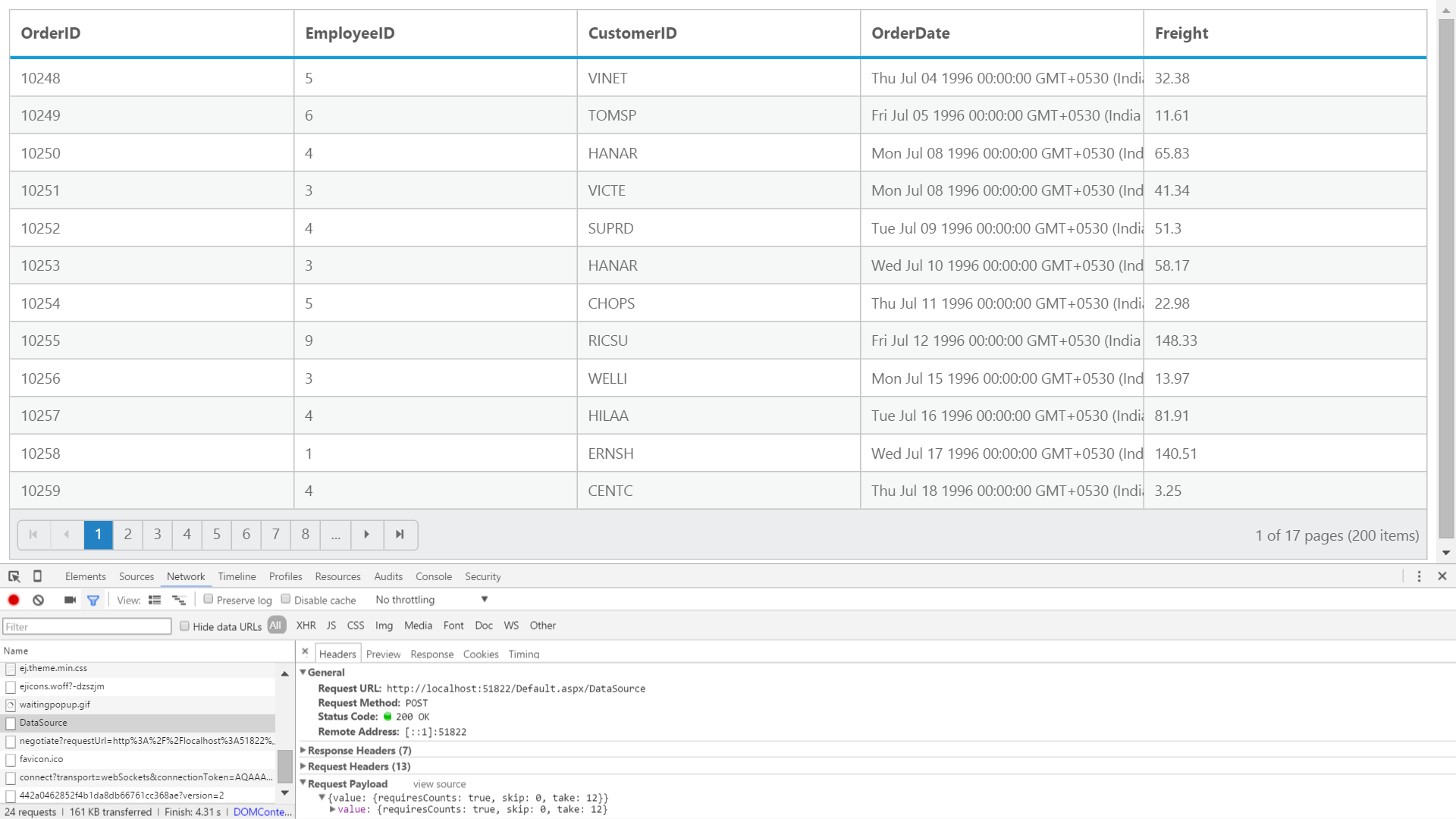
Url Adaptor
The Url Adaptor is the base adaptor that would interact with remote services. It can be enabled in Grid using Adaptor property of DataSource as UrlAdaptor. For every operations, an AJAX post will be send to the specified data service.
When using UrlAdaptor, grid actions such as Paging, Filtering and Sorting should be handled at the server side itself. We have DataOperation class to do these server side operations. Please refer to the kb link. These operations can also be done using the QueryableDataOperations class which accepts the IQueryable Data. Please refer the Kb link.
The following code example describes the above behavior.
<ej:Grid runat="server" ID="Grid" AllowPaging="true">
<DataManager URL="Default.aspx/DataSource" Adaptor="UrlAdaptor"/>
<Columns>
<ej:Column Field="OrderID" HeaderText="Order ID" TextAlign="Right" />
<ej:Column Field="CustomerID" HeaderText="Customer ID" />
<ej:Column Field="EmployeeID" HeaderText="Employee ID" TextAlign="Right" />
<ej:Column Field="Freight" HeaderText="Freight" Format="{0:C2}" TextAlign="Right" />
</Columns>
</ej:Grid>namespace Grid
{
using Syncfusion.JavaScript;
using Syncfusion.JavaScript.DataSources;
public partial class _Default : Page
{
protected void Page_Load(object sender, EventArgs e)
{
}
[WebMethod]
[ScriptMethod(ResponseFormat = ResponseFormat.Json)]
public static object DataSource(int skip, int take)
{
var db = new NorthwindDataContext().OrdersViews.ToList();
var res = db.Skip(skip).Take(take).ToList();
return new { result = res, count = db.Count };
}
}
}NOTE
- The response from server should be wrapped in an object with properties named
resultto hold the data andcountto hold the total records count.
NOTE
- The
countmust be returned along with response when paging is enabled in Grid.
The following output is displayed as a result of the above code example.
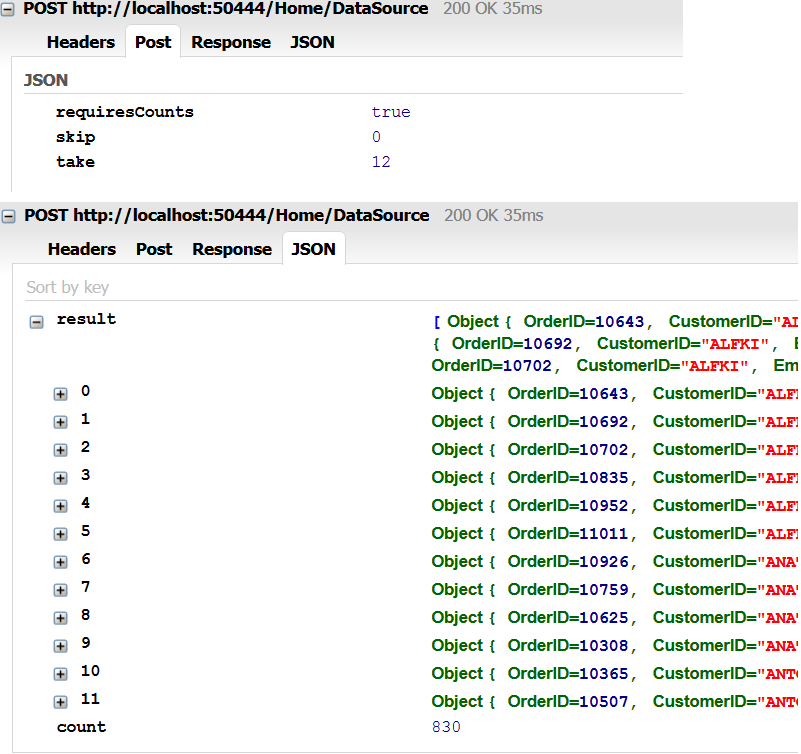
OData Adaptor
OData Adaptor that is extended from UrlAdaptor, is used for consuming data through OData Service.
We have an online OData Service “https://js.syncfusion.com/demos/ejServices/Wcf/Northwind.svc/Orders” created specifically for Syncfusion Controls
NOTE
ODataAdaptoris the default adaptor ofDataManagerand so no need to specify adaptor when binding OData service
You can use the following code example to use OData adaptor.
<ej:Grid ID="OrdersGrid" runat="server" AllowPaging="true">
<DataManager URL=http://js.syncfusion.com/demos/ejServices/Wcf/Northwind.svc/Orders/ Adaptor="ODataAdaptor></DataManager>
<Columns>
<ej:Column Field="OrderID" />
<ej:Column Field="EmployeeID" />
<ej:Column Field="CustomerID" />
<ej:Column Field="ShipCountry" />
<ej:Column Field="Freight" />
</Columns>
</ej:Grid>The following output is displayed as a result of the above code example.
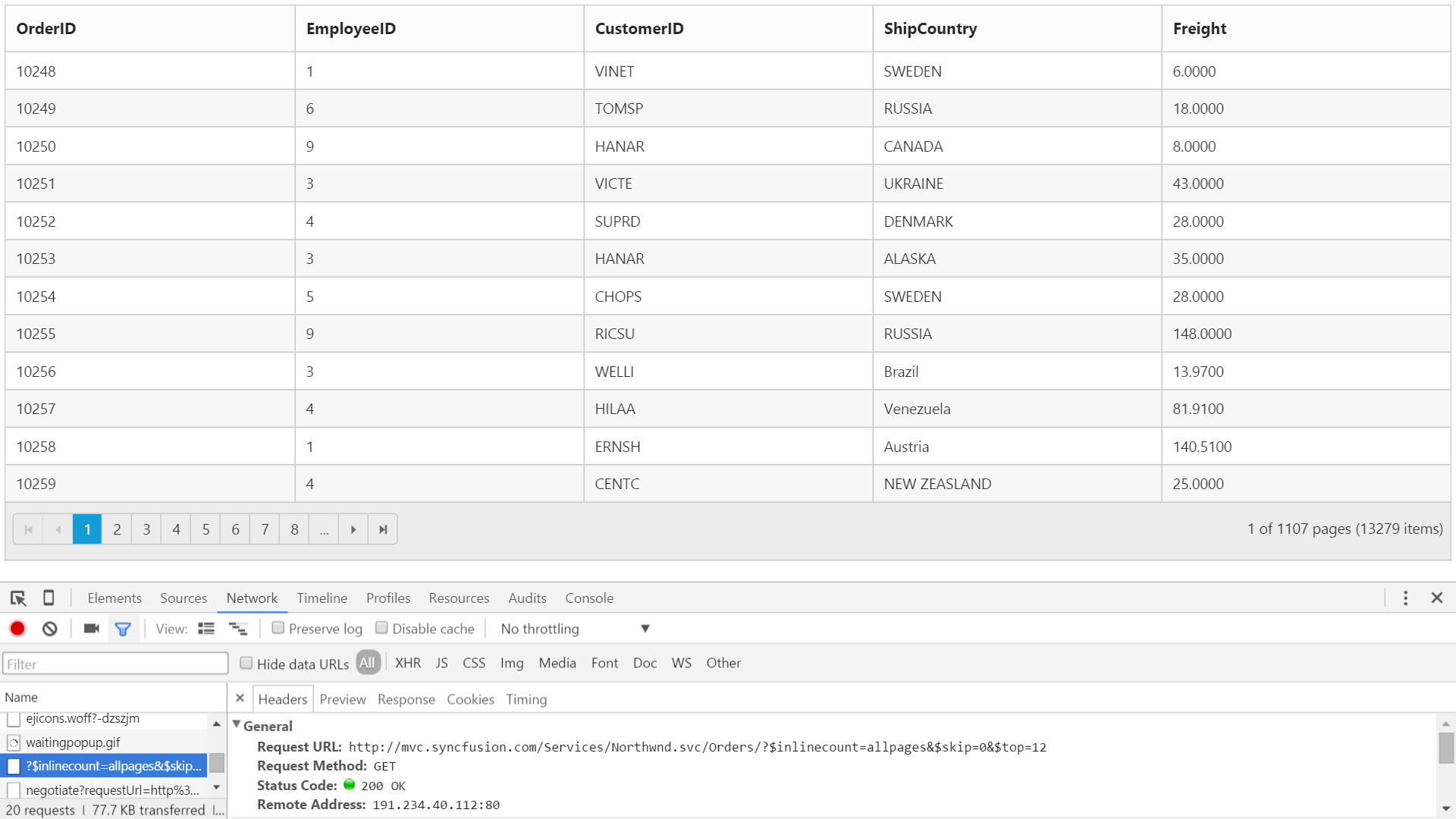
ODataV4 Adaptor
OData V4 Adaptor that is extended from ODataAdaptor, is used for consuming data from OData V4 Service
To consume OData V4 service, set the service link to the Url property and you can set adaptor type as ODataV4Adaptor to the Adaptor Property of Grid DataManager
You can use the following code example to use ODataV4 adaptor.
<ej:Grid ID="OrdersGrid" runat="server" AllowPaging="true">
<DataManager URL= http://js.syncfusion.com/demos/ejServices/Wcf/Northwind.svc/Orders/ Adaptor="ODataAdaptor></DataManager>
<Columns>
<ej:Column Field="OrderID" />
<ej:Column Field="EmployeeID" />
<ej:Column Field="CustomerID" />
<ej:Column Field="ShipCountry" />
<ej:Column Field="Freight" />
</Columns>
</ej:Grid>The following output is displayed as a result of the above code example.
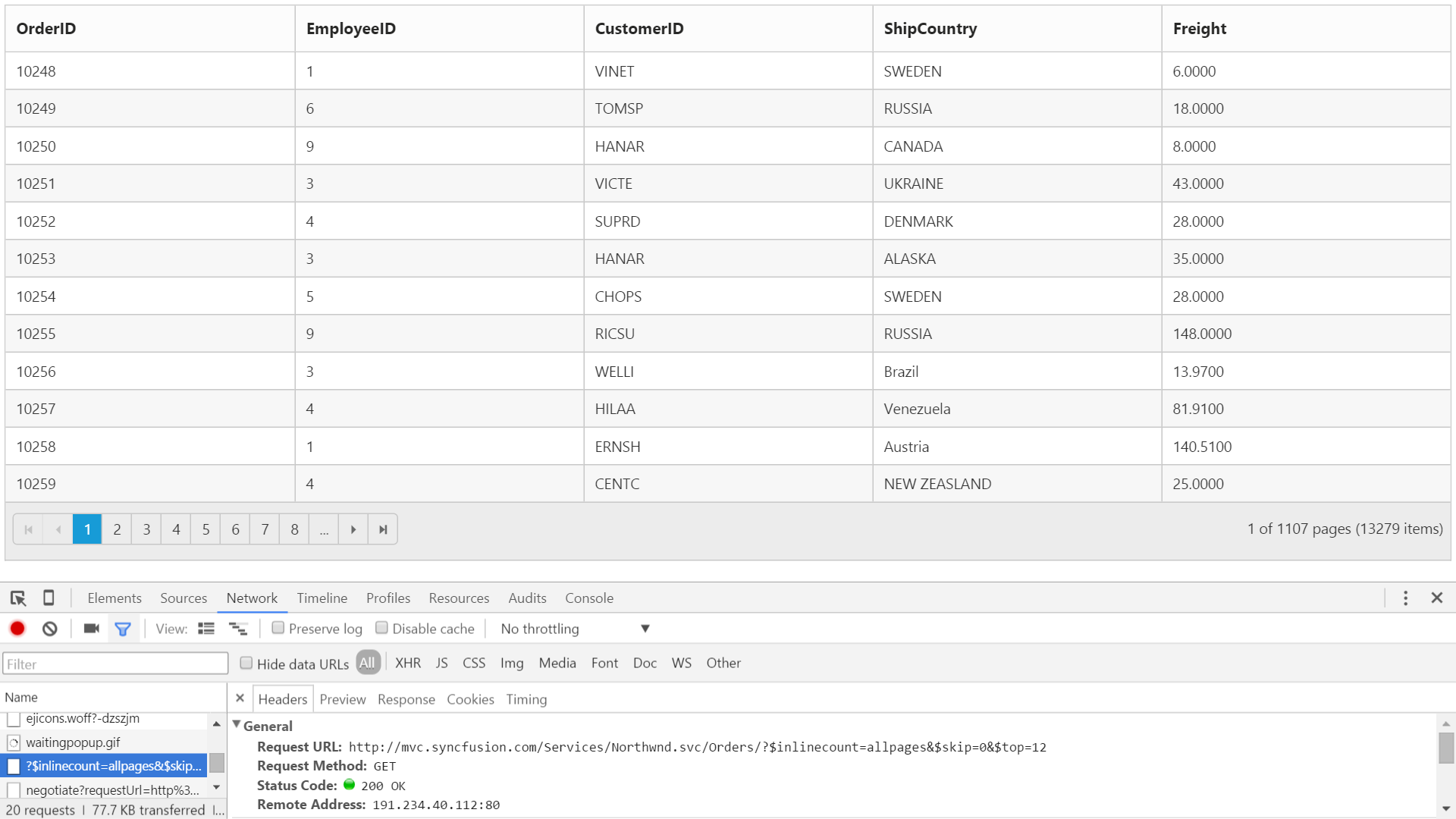
WebAPI Adaptor
WebAPI Adaptor that is extended from ODataAdaptor, is used for consuming data from WebApi Service
To consume Web API service, set the service link to the Url property and set the adaptor type as ` WebApiAdaptor to the Adaptor Property of Grid DataManager`.
You can use the following code example to use WebAPI adaptor.
<ej:Grid ID="OrdersGrid" runat="server" AllowPaging="true">
<DataManager URL=http://js.syncfusion.com/demos/ejServices/Wcf/Northwind.svc/Orders/ Adaptor="WebApiAdaptor></DataManager>
<Columns>
<ej:Column Field="OrderID" />
<ej:Column Field="EmployeeID" />
<ej:Column Field="CustomerID" />
<ej:Column Field="ShipCountry" />
<ej:Column Field="Freight" />
</Columns>
</ej:Grid>namespace EJGrid.Controllers
{
public class OrdersController: ApiController
{
// GET: api/Orders
NORTHWNDEntities db = new NORTHWNDEntities();
public object Get()
{
var queryString = HttpContext.Current.Request.QueryString;
int skip = Convert.ToInt32(queryString["$skip"]);
int take = Convert.ToInt32(queryString["$top"]);
var data = db.Orders.Skip(skip).Take(take).ToList();
return new { Items = data.Skip(skip).Take(take), Count = data.Count() };
}
}
}The following output is displayed as a result of the above code example.
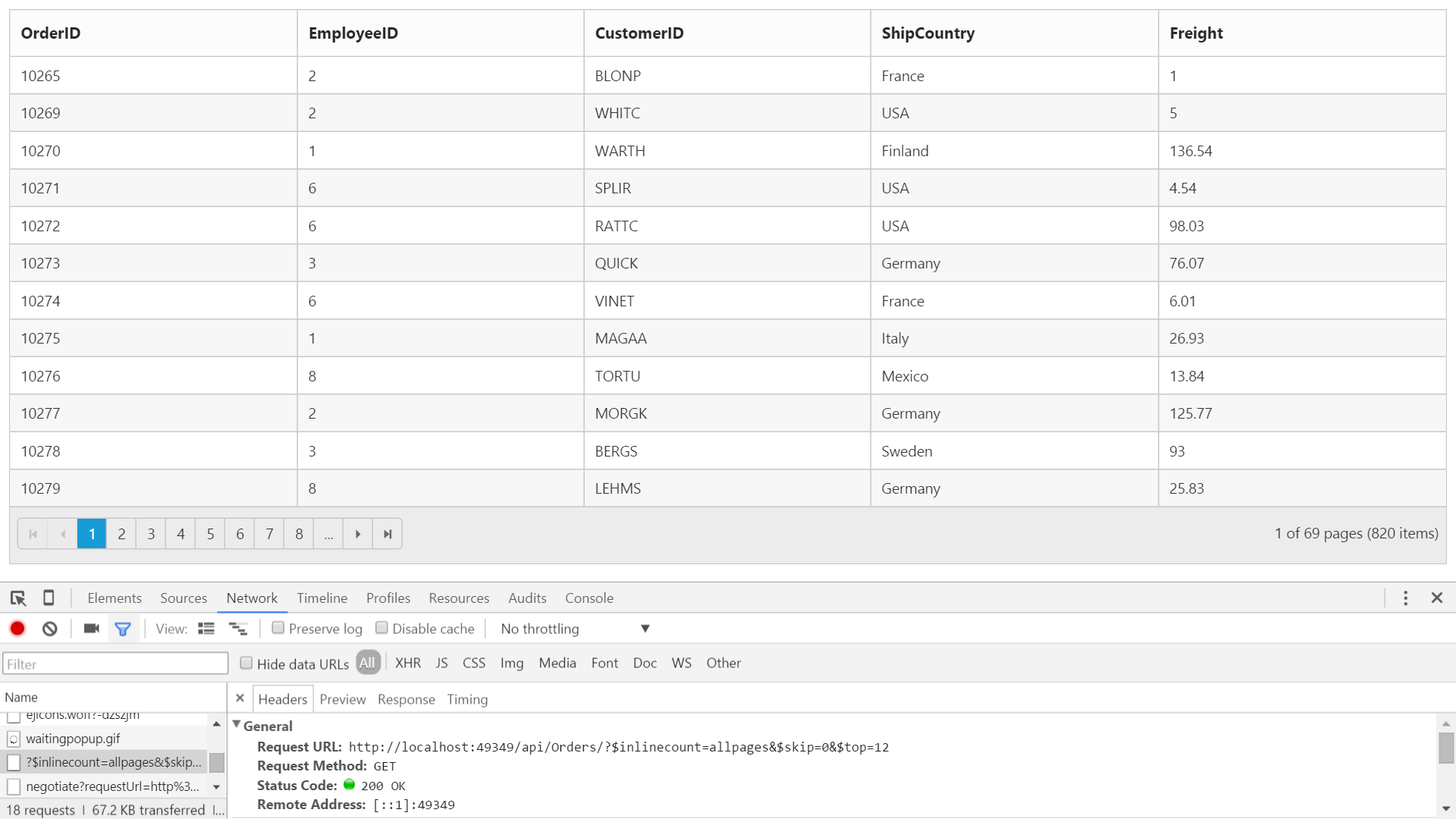
RemoteSave Adaptor
Sometimes you may need to perform all Grid Actions in client-side except the CRUD operations that should be interacted with server-side to persist data. It can be achieved in Grid by using RemoteSaveAdaptor.
Datasource must be set to Json Property and set adaptor type as remoteSaveAdaptor to the Adaptor Property of Grid DataManager.
CRUD operations can be mapped to server-side using UpdateUrl, InsertUrl, RemoveUrl, BatchUrl, CrudUrl properties.
You can use the following code example to use RemoteSave adaptor.
<ej:Grid ID="OrdersGrid" runat="server" AllowPaging="true">
<EditSettings AllowEditing="true" AllowAdding="true" AllowDeleting="true"></EditSettings>
<ToolbarSettings ShowToolbar="true" ToolbarItems="add,edit,delete,update,cancel"></ToolbarSettings>
<Columns>
<ej:Column Field="OrderID" IsPrimaryKey="true" />
<ej:Column Field="EmployeeID" />
<ej:Column Field="CustomerID" />
<ej:Column Field="ShipCountry" />
<ej:Column Field="Freight" />
</Columns>
</ej:Grid>namespace Sample
{
public partial class _Default : Page
{
protected void Page_Load(object sender, EventArgs e)
{
this.OrdersGrid.DataManager = new DataSource() {Json= OrderRepository.GetAllRecords()};
}
[WebMethod]
[ScriptMethod(ResponseFormat = ResponseFormat.Json)]
public static object Update(EditableOrder value)
{
OrderRepository.Update(value);
return value;
}
[WebMethod]
[ScriptMethod(ResponseFormat = ResponseFormat.Json)]
public static object Insert(EditableOrder value)
{
OrderRepository.Insert (value);
return value;
}
[WebMethod]
[ScriptMethod(ResponseFormat = ResponseFormat.Json)]
public static void Remove(int key)
{
OrderRepository.Delete(key);
}
}
}The following output is displayed as a result of the above code example.

On performing CRUD operations in Grid, the record changes will be sent to server-side as in the following screenshot.

Foreign Key Adaptor
The Grid can have a look up column. The Foreign key column using ForeignKeyField has some limitations such as sort/group operations on column will happen based on Field instead of ForeignKeyField. The ForeignKeyAdaptor can be used to overcome this limitation.
It works by specifying a virtual column (which is not in the grid datasource) in the Grid. This adaptor should be initialized in the Load event of the grid. ForeignKeyAdaptor supported for only local data binding.
The following code example describes the above behavior.
<ej:Grid runat="server" ID="Grid" AllowPaging="true" AllowSorting="true">
<Columns>
<ej:Column Field="OrderID" HeaderText="Order ID" TextAlign="Right" />
<ej:Column Field="CustomerID" HeaderText="Customer ID" />
<ej:Column Field="FirstName" HeaderText="FirstName"/>
<ej:Column Field="Freight" HeaderText="Freight" Format="{0:C2}" TextAlign="Right" />
</Columns>
<ClientSideEvents Load="OnLoad" />
</ej:Grid>namespace Grid
{
public partial class _Default : Page
{
public IEnumerable<EmployeeView> EmployeeView
{
get
{
return new NorthwindDataContext().EmployeeViews.ToList();
}
}
protected void Page_Load(object sender, EventArgs e)
{
this.Grid.DataSource = new NorthwindDataContext().OrdersViews.ToList();
}
}
}<script type="text/javascript">
<% var serializer = new System.Web.Script.Serialization.JavaScriptSerializer();%>
var employeeData = <%=serializer.Serialize(this.EmployeeView)%>
function OnLoad(args) {
this.model.dataSource.adaptor = new ej.ForeignKeyAdaptor([
{ foreignKeyField: "EmployeeID", foreignKeyValue: "FirstName", dataSource: employeeData }]
, "JsonAdaptor");
}
</script>NOTE
- The
Fieldname of the virtual column should be the name of the field to display from foreign datasource, in the above code example, FirstName column is the virtual column.
NOTE
- By default, the
ForeignKeyAdaptorusesJsonAdaptor, to use other adaptors specify the adaptor name as the second argument during initialization.
The following output is displayed as a result of the above code example.
